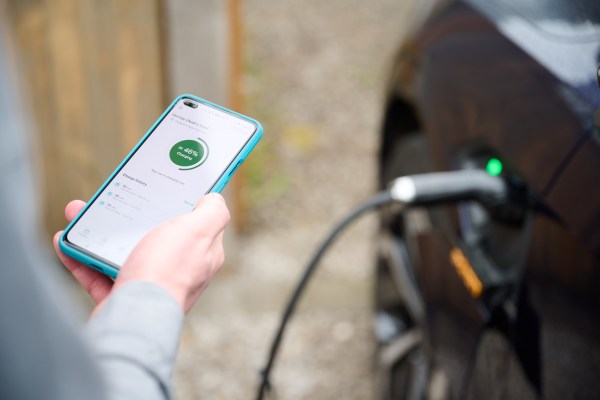One of the many benefits of electric vehicles is waking up to a full charge. Weekday commutes and weekend errands don’t have to be interrupted by emergency trips to the gas station. Instead, all drivers have to do is plug the car in every night, just like they do with their phones.
Most electric vehicle drivers plug in when they arrive home for the evening, typically around 6 p.m. Then they unplug at around 7 a.m. to leave for the day. But the vehicles themselves are typically drawing current for only about three hours.
Many EV chargers start delivering electrons immediately. For now, with EVs accounting for only a small portion of the market, that’s not much of a problem. But EV sales have been growing rapidly, and in the near future, when dozens of drivers plug in at around the same time, the surge of demand could easily overwhelm the grid.
That surge doesn’t have to happen, though. Most plugged-in EVs sit idle for about 10 hours every night, meaning if they could coordinate their charging sessions to smooth the demand curve, they’d save utilities billions in avoided electrical grid upgrades.
Some, not all, utilities have attempted to do this through time-of-use rates that offer consumers cheaper prices at times when demand is lower. That requires smart meters, which are far from ubiquitous. Others are attempting to flatten the curve by offering discounts or rebates on smart EV chargers that turn on when the grid has electricity to spare.
U.K.-based startup EV.energy is working to combine those nascent efforts with others into a software platform that can help tell drivers, EVs and chargers when and where to plug in. The company on Thursday announced a $33 million Series B led by National Grid Partners with participation from new investors Aviva Ventures, WEX Venture Capital and InMotion Ventures, as well as existing investors Energy Impact Partners, Future Energy Ventures and ArcTern Ventures.
While the company’s ultimate customers are utilities, it has to convince drivers to use its services. To do that, EV.energy coordinates with utilities like ConEd and National Grid to offer a range of incentives, from rebates or lower rates for charging during off-peak times to rewards for completing a certain number of off-peak charging sessions. Drivers with solar panels can also prioritize charging when their panels are producing, and customers who skip charging sessions during times of grid stress can earn bonuses.
To manage all that, though, takes some creative thinking. To get EVs charging at just the right time, EV.energy needs access to either the charger or the EV. As a result, the company has set up partnerships with charger manufacturers like Siemens and Maxeon and automakers like Volkswagen. Those companies in turn offer their customers the chance to connect to EV.energy’s network.
There’s also a range of capabilities on the utility side. “The level of sophistication across the utilities varies enormously,” co-founder and CEO Nick Woolley told TechCrunch+.
Some utilities have smart meters and sophisticated infrastructure that allows them to tell EV.energy which participating homes they want EVs to charge in and when. Others lack that entirely, instead telling EV.energy “more generally, how within an area of their grid, they would like it to control and manage electric vehicle load,” Woolley said. The company relies on models developed using data from millions of charging sessions to help determine what that management plan might look like.
Today, EV.energy has about 120,000 EVs on its platform that can flip on or off charging based on signals from the utilities. In the future, though, Woolley wants to extend EV.energy’s capabilities to include vehicle-to-grid (V2G) and vehicle-to-X (V2X) connections that would allow EVs to send power back to the grid or to power devices in the owner’s home.
“The potential for V2G and V2X is phenomenal,” Woolley said. His company has done studies looking at how a grid populated with V2G capable EVs would behave. Without them, EVs might add about 50% to peak loads, which would push utilities to spend billions in grid upgrades. So-called smart charging, where EVs draw power when requested, could reduce that increase by about half. But V2G has the potential to flatten the load curve entirely, Woolley said. “It’s phenomenally effective at helping to support the grid.”
EV.energy’s results jibe with at least one recent peer-reviewed study, suggesting that with the right equipment and software, the charging apocalypse that some utilities fear might not come to pass. Perhaps that’s why California lawmakers are considering requiring V2G on all vehicles sold in the state starting in 2030. The other step will be getting consumers to go along with it, which monetary rewards can help with.
Not everyone will want to put their battery on the grid, but the recent study suggests that in the near term, around 40% to 50% of drivers will need to in order to mollify the utilities. By the time EVs are widespread in 2040 or so, even fewer will be needed. Half of drivers is a pretty tall order, meaning that utilities will likely be pushed to do some upgrades. But given the age of the grid and rising electrification rates, shouldn’t they anyway?
